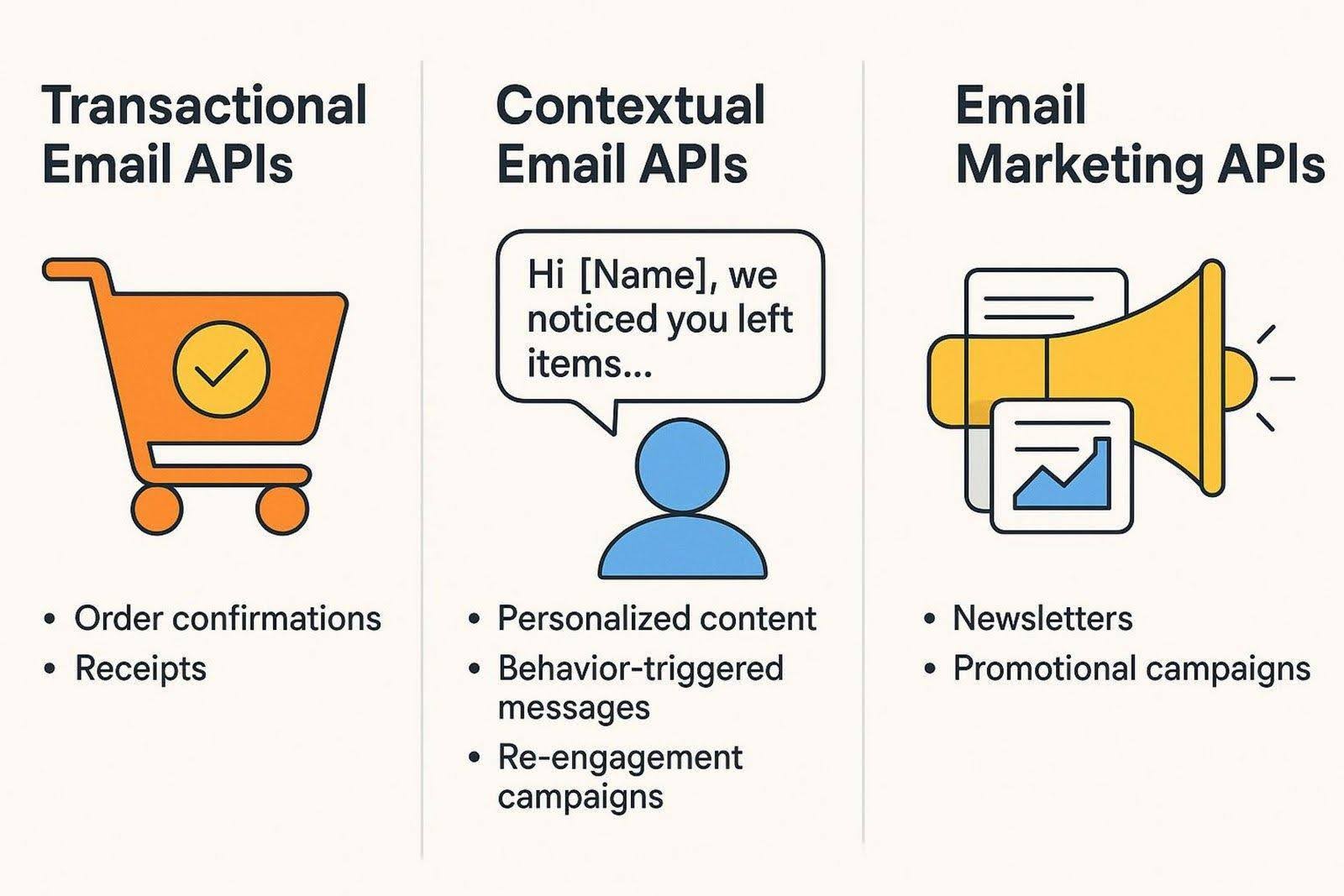In 2025, businesses are always looking for ways to make their operations smoother and reach their customers more easily.
Email is still a key way to communicate, but sending and managing emails by hand-especially in large amounts-can quickly become too much to handle.
This is where using an email API service provider is useful. These providers offer an easy but powerful way for businesses to automate and grow their email communications.
An email API (Application Programming Interface) basically lets your app talk directly to the email service provider’s system. This direct connection lets you do much more than you could with regular email programs, making it possible to build email features into your own tools and platforms.
The main advantages are better efficiency, stronger chances your emails get delivered properly, and the power to send large numbers of emails without problems.

What Is an Email API Service Provider?
An email API service provider is a company that gives you access to an email API, plus the servers and tech you need to add email sending and receiving into your own software.
You can think of them as specialists who take care of the technical side of sending huge amounts of emails so developers can add these features quickly and simply to their own apps.
They give you a set of tools, instructions, and systems so your software can easily send, receive, or manage emails.
With this setup, developers don’t have to know the details of email protocols like SMTP-they just use the API with simple website calls and secure keys. This approach saves time, avoids technical headaches, and lets businesses focus on their own customers instead of email infrastructure.
curl -X POST https://api.emailprovider.com/v3/send \
-H “Authorization: Bearer YOUR_API_KEY” \
-H “Content-Type: application/json” \
-d ‘{ “from”: “sender@yourdomain.com”, “to”: “recipient@example.com”, “subject”: “Hello from API!”, “text”: “This is a test email sent via API.” }’
How is an email API different from traditional email solutions?
The big difference between email APIs and regular email systems is how much control and programming you get. Regular email (like Outlook or Gmail) is made for people to send and read messages by hand.
While these work for individuals and small teams, they’re not good for sending large, automated, or personalized emails directly from your business systems.
Email APIs still use SMTP behind the scenes, but they let developers skip the hard parts and just use code to send emails. You don’t need to understand SMTP commands; you send requests with a key for safety, and you also get special features like analytics and template tools, which you don’t get with plain SMTP.
Types of Email APIs Businesses Use
- Transactional Email APIs: Used for messages triggered automatically by customer actions, like order confirmations, password resets, and shipping updates. The main focus here is speed and reliability.
- Contextual Email APIs: Great for sending marketing messages that change based on each user’s actions or details. This helps keep communications personal and engaging.
- Email Marketing APIs: Let businesses send mass marketing emails, manage mailing lists, and run marketing campaigns from within their own software. This is a step up from simply sending emails one by one.
API Type | Main Use | Examples |
Transactional | Order receipts, password resets, shipping alerts | Postmark, Mailgun |
Contextual | Personalized marketing emails based on user behavior | Custom integrations |
Email Marketing | Bulk newsletters, promotions, list management | Mailchimp Transactional, SendGrid |

Main Benefits of Email API Service Providers
- Email Workflow Automation: Apps can send emails automatically, triggered by specific events-no more manual work.
- Better Deliverability: Top providers have built strong setups and relationships to help your emails reach inboxes instead of spam folders.
- Personalization: APIs make it easy to fill emails with details unique to each customer, like their name or past orders.
- Tracking and Analytics: Providers give you dashboards and reports to see who opens and clicks your emails and help you adjust your strategy.
- Lower Costs: Setting up your own email system is expensive and complex. API providers let you pay only for what you send, with no need for big up-front costs.
Making Email Management Easier
As a business grows, the number of messages you need to send can make manual management impossible. Whether it’s order emails, password resets, or newsletters, doing it all by hand takes too much time and people. Email APIs let your systems handle those tasks as soon as an action happens, keeping things fast and error-free.
Improving Delivery to Inboxes
Ensuring your emails arrive in recipients’ inboxes (not their spam folders) is key. Email API providers maintain trusted relationships with ISPs, manage their own sending addresses, and follow the necessary setup to keep your sender reputation solid. They offer tools to help you monitor and improve these rates.
Customizing Email Content
Personal messages work better than general ones. By passing customer data (like names or recent purchases) to the API, your emails can be much more tailored. Most providers offer tools or templates that fill in this data, saving you time and increasing engagement.
Better Reporting and Insights
With built-in reporting and analytics, you can see which emails are being read, which links get clicked, and spot issues early. Using these insights helps you improve your messaging and avoid common pitfalls.
Saving Money Over In-House Solutions
Building your own email system takes time, money, and expertise-that’s out of reach for many businesses. Using a provider, you skip that hassle. They let you pay for what you use and avoid the costs of servers, staff, and ongoing updates.
How Email API Service Providers Automate Email Workflows
Email APIs take sending emails from a slow, manual job to a fast, automatic process. Your software sends simple requests to the API when something happens (like a customer makes a purchase), and the provider handles the rest. This lets messages go out instantly, every time.
Automation Features
- Template Management: Create and reuse consistent email designs with custom data dropped in automatically.
{
“template_id”: “welcome_email”,
“to”: “user@example.com”,
“from”: “no-reply@yourcompany.com”,
“variables”: {
“user_name”: “Alice”,
“company_name”: “MyTechCo”
}
}
- Scheduling: Set emails to send at specific times, great for marketing or reminders.
- Bulk Sending: Send thousands of messages at once without running into issues with limits.
- Webhooks: Get instant notifications back from the provider (for example, if a user opens, clicks, or reports an email as spam), allowing for follow-up actions.
{
“event”: “email_opened”,
“timestamp”: 1678886400,
“message_id”: “msg_abc123”,
“recipient”: “user@example.com”,
“user_agent”: “Mozilla/5.0 (Macintosh; Intel Mac OS X 10_15_7) AppleWebKit/537.36 (KHTML, like Gecko) Chrome/109.0.0.0 Safari/537.36”
}
Common Use Cases
- Transactional Emails: Order confirmations, shipping info, receipts, and account updates-sent instantly and reliably.
- Marketing Campaigns: Personalized promotions, triggered emails, and newsletters going to targeted segments.
- System Notifications: Alerts, reminders, status changes, and updates delivered quickly.
Integrating with Business Systems
Email APIs work best when connected directly to your CRM, e-commerce, or custom platforms. This means you can trigger emails based on actions in these systems, use your customer data for personalization, and keep all communication consistent.
How Email APIs Help Businesses Scale Email Volume and Performance
As your customer base grows, so does your email traffic. What starts with hundreds of messages quickly moves to thousands or more.
Using an API provider means you don’t have to worry about technical limits. Their cloud systems scale up automatically, making sure emails are sent on time and reliably-even during busy periods or campaigns.
High-Volume Infrastructure
Providers design their systems to handle big batches of emails without slowing down or failing. You don’t need to buy extra hardware; the system adjusts as needed. This is a big advantage compared to managing your own setup.
Speed, Reliability, and Uptime
Time is important for things like password resets or order updates. Top providers focus on delivering emails within seconds and keep outage risks very low, promising high availability for their services.
Real-Time Monitoring and Analytics
Even with millions of emails, you can watch delivery, open, and click rates in real time and respond to any issues that come up. This helps keep your reputation with ISPs clean and your customers happy.

Key Features to Seek When Choosing an Email API Service Provider
- API Sending & Receiving: Make sure you can both send outgoing emails and process incoming ones if needed. The API should support attachments, both plain text and HTML formats, and have secure authentication.
- Template and Dynamic Content Tools: Look for user-friendly template editors, support for custom HTML, and dynamic fields for personalization.
- Deliverability Support: Ensure they guide you through setting up protocols like SPF, DKIM, and DMARC, plus tools for managing bounce and unsubscribe lists.
- Security and Compliance: Encryption, access controls, and compliance with laws like GDPR or CCPA are a must-especially if you handle sensitive data.
- Strong Documentation and SDKs: Good guides, code examples, and software development kits make integration much easier. Responsive customer support helps, too, should issues come up.
Common Challenges and Risks with Email APIs
While email APIs offer many benefits, they also come with some risks:
- Deliverability Issues: Even with a provider, things like spam filters, poor content, or a bad sender reputation can cause emails to get blocked. Clean your lists often and follow best practices for content.
- Security Threats: If someone gets access to your API key, they can send emails in your name. Keep keys secure, set up access rules, and use features like IP allowlists if possible.
- Costs as Volume Grows: Most providers charge based on email numbers. Know your traffic and watch for increasing costs as your business scales. Understand the full fee structure, including extras for features or dedicated sending addresses.
- Scaling Own Systems: It’s not just about the API-make sure your own app can keep up with sending requests and processing data back from the provider.
How to Evaluate and Choose the Right Email API Service Provider
- Decide what types of emails you’ll send and how many-transactional, marketing, notifications, or all three.
- Check the provider’s deliverability track record and delivery rates.
- See how easily the provider’s system can scale as you grow.
- Compare base costs, feature charges, and support options.
- Dig into their documentation; good support and clear instructions are signs of a quality provider.
Provider | Best For | Main Benefits |
Sinch Mailgun | High-volume businesses | Good tracking, security, multi-language SDKs |
Postmark | Fast, reliable transactional emails | Speed, reliability, excellent for alerts |
Amazon SES | Budget-focused, AWS users | Affordable, scalable, easy integration |
SendGrid | SMBs and mid-sized companies | Marketing and transactional features |
Mailchimp Transactional API | Current Mailchimp users | Integrated marketing tools, easy automation |
Best Practices for Implementing and Optimizing Email API Integration
- Study the documentation and use SDKs for your programming language.
- Test thoroughly in a safe (development) setup before going live.
- Personalize emails and segment your mailing lists for better results.
- Regularly clean your mailing lists-remove bounced or inactive addresses.
- Monitor analytics, check for sudden drops or spikes, and investigate issues quickly.
- As you grow, review your API needs and look at advanced features like dedicated IPs or multi-provider setups.
Real-World Examples: Automation and Scaling with Email API Providers
- E-Commerce: Online stores rely on APIs to send order confirmations, shipping updates, and receipts instantly. Customers know what’s happening and support requests go down.
- SaaS Platforms: Welcome emails, activation links, password resets, and security notifications are all triggered by API calls, improving onboarding and safety for users.
- Marketing Teams: Instead of sending bulk campaigns by hand, marketers use APIs to schedule, personalize, and track mass emails directly linked to their own CRM or marketing software.
Transactional Email in E-Commerce
When a shopper buys from an online store, an API call instantly sends a detailed receipt. As their order is packed and shipped, more emails are triggered to keep them updated. These can also recommend other products, leading to more repeat customers.
SaaS: Automated User Notifications
For software platforms, everything from signing up to security alerts can be handled through automatic email triggered by the API-making for a smoother and safer user experience.
Managing Bulk Marketing Campaigns
Marketing teams can easily run promotions and newsletters, sending thousands of emails at once, personalizing content, and tracking performance, all through a single integration with an email API.
Conclusion
As the pace of business continues to increase, relying on manual email processes isn’t practical. Email API service providers are now an essential tool for any company wanting efficient, automated, and large-scale emails. These systems help automate workflows, personalize messaging, and achieve strong delivery rates.
Looking ahead, features like built-in AI will likely make these systems even better-helping block spam, personalize even more deeply, and maybe even help create content. At the same time, businesses can count on ongoing improvements to privacy and security tools, as compliance needs and customer expectations grow. Email API technology is now a core part of every successful business’s communication strategy.

Founder Dinis Guarda
IntelligentHQ Your New Business Network.
IntelligentHQ is a Business network and an expert source for finance, capital markets and intelligence for thousands of global business professionals, startups, and companies.
We exist at the point of intersection between technology, social media, finance and innovation.
IntelligentHQ leverages innovation and scale of social digital technology, analytics, news, and distribution to create an unparalleled, full digital medium and social business networks spectrum.
IntelligentHQ is working hard, to become a trusted, and indispensable source of business news and analytics, within financial services and its associated supply chains and ecosystems










